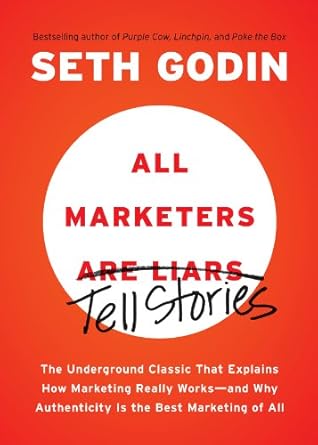More on this book
Community
Kindle Notes & Highlights
by
Seth Godin
Read between
August 18 - September 9, 2019
Why did John Kerry lose against an incumbent with near-record-low approval ratings after spending more than $100,000,000 on his campaign? Simple. He didn’t tell a coherent story, a lie worth remembering, a story worth sharing.
The temptation in politics is to be so certain of the facts of your case that you arrogantly believe you can persuade people to change their minds. But voters, like all consumers, hate to admit they’re wrong. The only way to change minds is to somehow get past the filters and safeguards that people erect to insulate themselves from opposing points of view—and then to tell a story that spreads.
The people who buy for business are people first, and they buy things that get them promoted, that make them feel safe and secure or that give them a sense of belonging.
And that’s what you’re buying—not software, but the justification, the story.
Step 4: Stories let us lie to ourselves. And those lies satisfy our desires. It’s the story, not the good or the service you actually sell, that pleases the consumer.
The lie the consumer tells herself is what matters.
In order to be believed, you must present enough of a change that the consumer chooses to notice it. But then you have to tell a story, not give a lecture. You have to hint at the facts, not announce them. You cannot prove your way into a sale—you gain a customer when the customer proves to herself that you’re a good choice. The process of discovery is more powerful than being told the right answer—because of course there is no right answer, and because even if there were, the consumer wouldn’t believe you!
Expectations are the engine of our perceptions. And complex stories carry all sorts of perceptions. Where people choose to shop, the way the transaction is handled, the noise, the music, the lighting—each element is at least as important as the item itself.
Storytelling works when the story actually makes the product or service better.
Marketing isn’t the problem. Marketing is just a tool. People are the problem. People with short-term pressures and greedy, selfish goals. But it’s not just the people in marketing who are responsible. Consumers are complicit as well. When they refuse to spend a few minutes understanding side effects and buy a story instead, consumers aren’t acting as adults, they’re just pawns.
Nuclear weapons have killed a tiny fraction of the number of people that unethical marketing has. It’s time we realized that there may be no more powerful weapon on Earth.
Telling people that they’ve believed a lie for a long time is no way to make friends. If it’s a good lie, a lie that led people to enjoy themselves or to be productive, then taking that lie away is actually hurtful. I hesitated to write a book about lies, just because we love these lies so much.
You don’t get to make up the story. The story happens with or without you. If you’re not happy with the story, the only way to change it is with direct contact between your consumer and a person.
The goal of every marketer is to create a purple cow, a product or experience so remarkable that people feel compelled to talk about it. Remarkable goods and services help ideas spread—not hype-filled advertising.
Humans are too smart to be fooled by a Potemkin village, a facade that pretends to be one thing and turns out to be another. Sure, you can fool some people once or twice, but this is the key lesson of the new marketing: once fooled, a person will never repeat your story to someone else. If you are not authentic, you will get the benefit of just one sale, not a hundred. The cost of your deception is just too high.
The most important principle is this: you cannot succeed if you try to tell your competition’s story better than they can. It’s almost impossible to out-yell someone with the same story.
The problem is that once a consumer has bought someone else’s story and believes that lie, persuading the consumer to switch is the same as persuading him to admit he was wrong. And people hate admitting that they’re wrong.
The only stories that work, the only stories with impact, the only stories that spread are the “I can’t believe that!” stories. These are the stories that aren’t just repeatable: these are the stories that demand to be repeated.
You succeed by being an extremist in your storytelling, then gracefully moving your product or service to the middle so it becomes more palatable to audiences that are persuaded by their friends, not by you.
A talented marketer is someone who takes a story and expands it and sharpens it until it’s not true anymore (yet). Your goal should not (must not) be to create a story that is quick, involves no risks and is without controversy. Boredom will not help you grow.
Unfortunately, a common worldview is to be afraid. There are plenty of things to be afraid of. A broken dishwasher out of warranty. Anthrax. Allergies. Getting trapped inside of your car. The flu. Even sounding dumb at a cocktail party. While these fears are wildly different, they represent the very same reflex. If your worldview is about protecting yourself or your family, you’ll respond extremely well to an offer that’s framed in terms of your fear. No, this won’t appeal to everyone in a given marketplace. But those grappling with fear are unlikely to respond to anything else.


